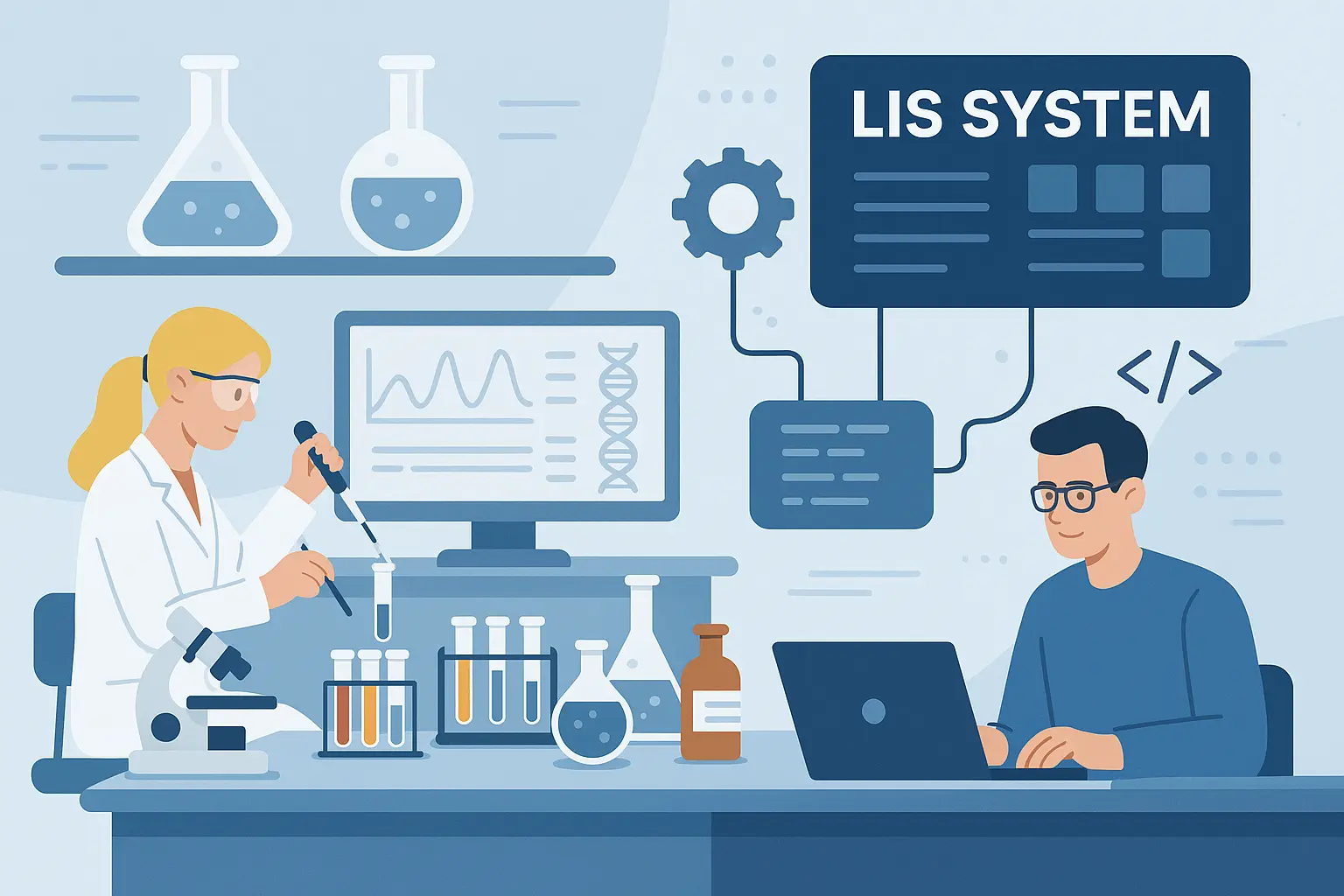Blog
How Best Practices and Advanced Laboratory Information System Technology Help Ensure Lab Workflow Management
April 16, 2025
Sometimes the most basic problems are the hardest to solve.
Take laboratory workflow management as an example. How can clinical labs and pathology groups ensure they have streamlined lab workflow and end-to-end data integrity at every stage of the specimen lifecycle (pre-analytic, analytic, and post-analytic)?
Issues with lab workflow and data management systems, like diagnostic lab software, lead to processing errors and delayed test results within the laboratory, and both can have severe consequences downstream in terms of patient care and malpractice claims.
Because of this, medical laboratories are constantly looking for tools such as efficiency tracking software and better ways to manage lab workflow and data to protect the patients they serve.
Learn More: Automate Complex Processes & Simplify Clinical Lab Operations with LigoLab Informatics Platform
A Two-Pronged Approach to Lab Workflow Management and Data Integrity
To solve this basic problem of effective lab workflow management and data integrity, the best medical lab operators deploy a combination of stringent adherence to established best practices, plus advanced laboratory information system (LIS medical solutions) technology with the latest laboratory data analysis software.
Let’s start by examining how established best practices positively relate to accurate and reliable clinical laboratory management and ultimately to better patient outcomes.
- Quality Control: Medical laboratories should implement quality control programs to ensure the accuracy and reliability of their testing. This entails regularly monitoring test results and analyzer/equipment performance, proficiency testing, and internal quality assessments.
- Standard Operating Procedures: Medical laboratories should have well-documented (and regularly updated) standard operating procedures, or SOPs, for all laboratory processes. From sample tracking to data reporting and everything in between, SOPs should include protocols for identifying and reporting errors and variances, and correcting them promptly.
- Staff Education and Training: Medical laboratories should provide regular training and education on new testing methodologies, systems, equipment, and procedures. This helps ensure that laboratory staffers are knowledgeable and up-to-date on the lab’s best practices. It also helps with staff retention and the onboarding of new staff members.
- Information Security: Medical laboratories should implement modern and robust data security protocols to protect patient privacy and prevent unauthorized access to Protected Health Information (PHI). This includes password protection, encryption, and restricted access to sensitive data.
- External Quality Assurance: It’s also a good idea for medical laboratories to participate in external quality assurance programs, such as proficiency testing and accreditation programs, to ensure that their testing meets recognized standards of quality and accuracy.
Learn More: A Detailed Look at How Modern Laboratory Information Systems Fully Support Quality Control
Next, let’s examine how these best practices and advanced lab information system technology can ensure data integrity from placing a test order to generating and distributing a lab report.
Lab operators in the know understand that best practices can only take them so far and that pathology lab reporting software in the form of modern laboratory information systems (LIS systems) is a necessity for any laboratory interested in scaling productivity without increasing the chance of medical errors and sacrificing the quality of patient care.
It’s also a necessity for the two big interrelated issues the pathology industry is now faced with, and that’s dealing with laboratory burnout linked to all-time high diagnostic testing volumes and a serious shortage of qualified laboratory personnel to manage the workload.
Fortunately, pathologists, medical directors, lab managers, lab techs, and all other laboratory personnel are used to doing more with less. In this case, that means implementing strategies to become more efficient and productive without adding human resources and additional costs.
On-Demand Webinar: How Standardization and Enhanced Reporting Capabilities Improve Lab Workflow and Overall Business Operations
.webp)
The Advantages of Modern Medical LIS Systems
The current environment calls for laboratory efficiency gained by the process optimization detailed earlier, where bottlenecks are identified and eliminated, and by LIS laboratory information system software upgrades that take advantage of automation and the latest pathology lab management technologies.
When introduced into a clinical lab workflow, LIS software automation streamlines and simplifies routine tasks, such as:
- Automating Data Entry: A modern medical LIS system can automate entering data into its system, reducing the need for manual data entry and minimizing errors. An example is integrating a medical LIS with a health system’s electronic health record (EHR) for the bidirectional digital transmission of patient and specimen data.
- Streamlining Workflows: A modern lab information system in healthcare can automate tasks like sample tracking, test ordering, and test result reporting. This LIS lab automation improves efficiency and reduces the risk of delays caused by errors and lost specimens.
- Improving Data Accuracy: A modern medical LIS can help the laboratory enforce standard protocols for data entry and provide validation checks as data is entered into the system.
- Enhancing Data Security: The best LIS system can help to ensure data security in all departments by providing access controls, audit trails, and encryption.
- Providing Real-Time Data Access: A modern healthcare LIS can provide real-time access to laboratory data with just a few clicks, enabling LIS staffing to quickly and easily retrieve test results, track the status of specimens, and monitor laboratory operations at both a high and granular level.
- Facilitating Data Analysis: A modern LIS system software can facilitate data mining and analysis, enabling the C-suite and department heads to identify trends and patterns in laboratory data and proficiency.
Learn More: Best LIS Software - Maximize Growth With Cutting Edge Pathology Lab Management Software
.webp)
Simplify, Automate, Succeed: The Role of Modern LIS Systems in Lab Workflow Optimization
Modern LIS systems also support other laboratory software systems and automation within the lab, uniting all laboratory informatics into one source of truth that improves accuracy, reduces test turnaround times, and frees up staff time for more complex tasks.
Here are a few examples that demonstrate how modern pathology LIS systems can support other diagnostic lab software and help create simplified laboratory workflow management:
- Tissue Processing: Automation can be used to streamline the prepping of tissue for analysis (fixation, embedding, and sectioning). Automated tissue processors boost productivity by handling multiple specimens at once, and they can also be programmed to run overnight, greatly reducing the time required for processing.
- Slide Staining: Automated slide stainers can apply stains to tissue sections, and these systems can also be programmed to produce multiple stains on a single slide. Automation leads to quick and accurate processing of a large volume of slides.
- Digital Imaging: Digital pathology involves digital imaging technology to capture high-resolution images of tissue specimens, which are viewed via a computer monitor rather than a microscope. The capturing of images is quick and accurate. With the assistance of a modern medical LIS, these images can be easily included along with other diagnostic information on the lab report.
- Image Analysis: Automated laboratory data analysis software can be used to analyze vast amounts of digital images of tissue specimens in a short period to identify the presence of abnormalities such as cancer cells, aiding the pathologist with more accurate diagnoses.
- Report Generation: Automated pathology reporting software can generate reports with summaries of the findings from the analysis of tissue specimens. The pathology software can be programmed to generate reports quickly and accurately, reducing the risk of errors and improving the speed of diagnosis.
Choosing the Right LIS System: What Modern Labs Need - and What to Avoid
Now, a word of caution. All LIS systems aren’t created equally with advanced automation capabilities. There are automated labs with modern LIS systems, and then there are inefficient labs saddled with legacy LIS systems that are rigid, inflexible, and unreliable.
The best LIS software can combine advanced automation with comprehensive and highly configurable modules that can:
- Standardize all technical and financial processes (laboratory billing)
- Boost productivity and accuracy
- Seamlessly integrate with your existing systems
To learn more and make sure that the LIS systems and laboratory information system vendors you’re researching offer modern and reliable LIS software solutions, click the link below and read a modern vs. legacy lab information system comparison.
Learn More: Comparing LigoLab Informatics Platform with Legacy Laboratory Information System Software
And here’s an additional post that details what lab leadership should know before contracting with a particular LIS company.
Learn More: What You Need to Know Before Contracting with a Laboratory Information System (LIS) Company
Are you ready to learn more?
Click below to contact us at LigoLab and set up a 15-minute introductory call with a lab information system specialist who can answer all your questions.






